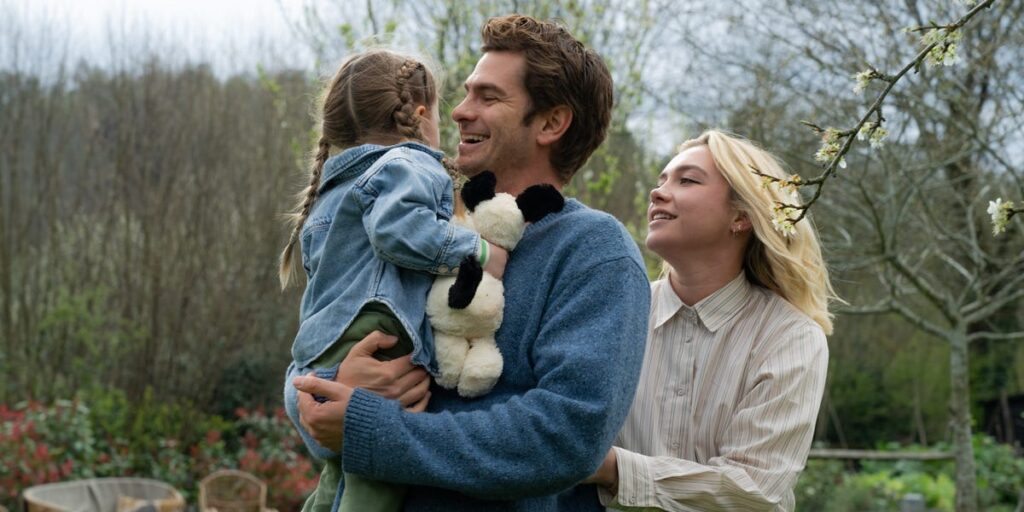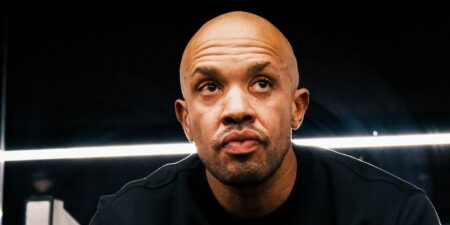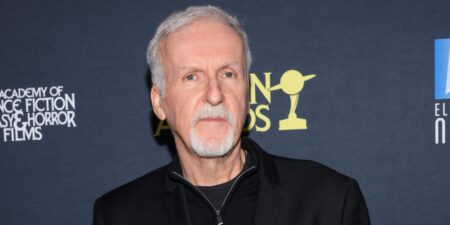- Andrew Garfield and Florence Pugh star as a couple dealing with a cancer diagnosis in “We Live in Time.”
- BI spoke to director John Crowley about how the film’s tone balances romance and melodrama.
- Crowley also discussed the most challenging scenes and how the ending changed.
“We Live in Time,” the new film starring Florence Pugh and Andrew Garfield as a couple dealing with a cancer diagnosis, defies easy categorization.
The movie, which is structured as a nonlinear narrative, follows the relationship between Tobias (Garfield), a Weetabix salesman, and Almut (Pugh), a former figure skater turned Michelin chef, over the course of a decade.
It’s funny and romantic, but it’s not a rom-com. It’s dramatic and heart-wrenching and deals with cancer, but it’s not deliberately weepy like “The Fault in Our Stars” or “A Walk to Remember.”
Though the “We Live in Time” director John Crowley saw balancing the film’s many tones as an invigorating challenge for him and his actors, some of the suits involved were less enthused.
“It made our financiers very nervous, certainly, because there’s a restlessness about the script,” Crowley told Business Insider, adding that it’s this tone that gives the movie its “life force.”
“It’s constantly refusing to settle down into one kind of thing. And that’s why it refuses the guardrails of a rom-com, or of a melodrama.”
Yet with Garfield and Pugh, two beloved and reliably bankable stars at the center of his film, Crowley, who’s best known for the Oscar-nominated Saoirse Ronan vehicle “Brooklyn,” ultimately had little to worry about.
Pugh and Garfield’s undeniable chemistry both onscreen and on their press tour has garnered the film plenty of buzz: They’ve discussed everything from sending nudes to getting carried away filming sex scenes on the record. When Pugh couldn’t appear at the London Film Festival because she was shooting another movie, Garfield walked the red carpet with a life-sized cardboard cutout of her, much to the amusement of fans.
And then there’s the movie’s most inadvertent meme: the carousel horse, whose strange expression captured in the corner of one of the film’s promotional photos went viral.
“It was so good-natured, all of the teasing about it,” Crowley said. “For once, all publicity is good publicity. It’s not always true nowadays, but I think, in this instance, it was.”
Below, Crowley spoke to BI about the most challenging scenes for Pugh and Garfield to film, how the ending changed, and how much crying there was behind the camera.
The actors — and director — went through the emotional wringer
When it came to translating that restless script to screen, Crowley praised Garfield and Pugh for “hitting the bullseye on a daily basis.” He pointed to the big birth scene, a key sequence in the film in which Almut ends up delivering their daughter Ella in a gas station bathroom after they get stuck in traffic on New Year’s Eve, as one of the most exhausting scenes to film.
“[Pugh] gave birth eight times in one day,” Crowley said. “And those takes ran long. There were sort of 16-minute takes or something like that.”
He also pointed to Almut and Tobias’ climactic argument in the kitchen over her decision not to undergo treatment and instead focus on training to compete in a culinary competition as one scene that was “blisteringly raw” and tough for Garfield. The scene was shot toward the end of filming and Garfield, who’d gone through much of Tobias’ emotional arc by that point, was left “profoundly upset” after filming it.
“In a way, he himself could feel Tobias’ grief after that scene, which is, she’s gone. She’s going to do what she wants to do, and I’m left watching it. But she’s gone,” Crowley recalled. “He could feel that that was the beginning of the end.”
Garfield also lost his mom to cancer in 2019.
“It really hit him very, very deeply,” Crowley added.
That level of lingering emotion wasn’t unique to Garfield, either. Crowley said he, too, got emotional on set watching Garfield and Pugh act out some of the movie’s most intense scenes. And he got worked up all over again while editing the movie six months later.
“There was a lot of emotion flying on that set,” he said. “So yeah, I was a wreck.”
The ending of ‘We Live in Time’ was originally different
The sequence of scenes in the film, which tells the couple’s love story out of order, also changed during the editing process. Scenes initially intended to open and close the film ended up in different spots entirely.
Crowley said the film originally opened on Tobias and Almut being spun around in the fairground, where they went to celebrate Almut’s cancer remission. The original ending bookended that; the last dialogue scene was Almut coming through the door of their apartment and telling Tobias that she was in remission after her first bout of cancer.
Those scenes both still exist in the final cut of the movie, but were instead placed three-quarters of the way through and happen in chronological order: Almut first reveals her remission and then the two go to the fairground to celebrate.
The ending that made it to the screen is a beautifully understated sequence: After competing in the Bocuse d’Or culinary competition, a satisfied and fulfilled Almut brings Tobias and their daughter Ella to an ice-skating rink. The family skates together, revisiting Almut’s past as a competitive figure-skater — a passion she abandoned over her grief when her own father died.
That scene ends with Almut skating further away from her partner and daughter and waving to them, functioning as a farewell to Almut for both her family and the audience. The next scene cuts to Tobias and Ella, an unspecified period of time later, entering the family’s cottage home. It’s never said aloud, but it’s clear that Almut has since died.
Crowley said there was never any plan to show Almut’s death onscreen. “It was never filmed,” he said. “The ice skating sequence and the waving from across the way was always intended to carry the import of a goodbye.”
To Crowley, that scene was meant to convey for the viewer the sense of sudden finality when someone you love dies, which is always abrupt and feels too soon.
“They wave goodbye at this beautiful triumphant moment and then it’s just emptiness. It would feel like, you got to be kidding me, right? She’s coming back, of course, which is what you feel when somebody goes,” he said.
He also points to the dog that appears for the first time in the final scene of the film as a subtle clue that Almut has died, calling back to earlier in the film when Almut half-jokingly suggests getting an older dog to help their daughter cope with the concept of death.
The egg-cracking moment is another motif brought back in the ending. That happens three times throughout the film: in the opening scene, when we’re first introduced to Almut, then early in Tobias and Almut’s relationship when she explains to him her method for egg-cracking (always on a flat surface and into a smaller bowl before it’s transferred to a larger bowl), and then in the final scene where Tobias and their daughter are using Almut’s egg-cracking method after she died.
It’s a quick moment that takes on greater import: a simple, profound way of showing how Almut lives on for her daughter.
Crowley knew it would be a risk to wrap up the film with what might be perceived as a lack of closure. But whether or not it landed with every viewer, it felt like the most genuine ending for the director — and for his characters.
“It would be a truer expression of what it feels like to lose somebody very precious to you,” he said. “It felt like the right place to leave them to go on that journey.”
“We Live in Time” is in theaters now.
Read the full article here
















